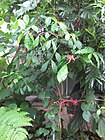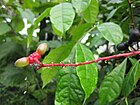Note: This is a project under development. The articles on this wiki are just being initiated and broadly incomplete. You can Help creating new pages.
Quassia amara - Bitter wood
Quassia amara (amargo, bitter-ash, bitter-wood) is a species in the genus Quassia, with some botanists treating it as the sole species in the genus. The genus was named by Carl Linnaeus who named it after the first botanist to describe it: the Surinamese freedman Graman Quassi. Q. amara is used as insecticide, in traditional medicine and as additive in the food industry.
Uses
Intestinal parasites, Skin parasites, Intestinal parasites, Amebic infections, Malaria, Digestive problems, Eliminate toxins, Liver.
Parts Used
Chemical Composition
The main chemicals identified in amargo include: beta-carbolines, beta-sitostenone, beta-sitosterol, dehydroquassins, gallic acid, gentisic acid, hydroxyquassins, isoparain[1]
Common names
| Language | Common name |
|---|---|
| Kannada | |
| Hindi | |
| Malayalam | |
| Tamil | |
| Telugu | |
| Marathi | NA |
| Gujarathi | NA |
| Punjabi | NA |
| Kashmiri | NA |
| Sanskrit | |
| English |
Habit
Identification
Leaf
| Kind | Shape | Feature |
|---|---|---|
| simple | Alternate, Pinnate | ative to Brazil, Bitter Quassia ia a small forest tree, typically with a leaning stem, sometimes multiply-stemmed. Leaves are alternate, compound, with 3-5 leaflets, one terminal and the remaining in opposing pairs. The rachis between the leaflets is conspicuously winged. The leaves and bark have an unpleasant bitter flavor if chewed |
Flower
| Type | Size | Color and composition | Stamen | More information |
|---|---|---|---|---|
| Unisexual | 15-25 cm long | white | The flowers are produced in a panicle 15-25 cm long, each flower 2.5-3.5 cm long, bright red on the outside, and white inside. They are tubes with a narrow mouth, somewhat wider at the base |
Fruit
| Type | Size | Mass | Appearance | Seeds | More information |
|---|---|---|---|---|---|
| Syncarp (sorosis) The fruit consists of 4-5 berries held together in a red receptacle; the fruits themselves are green, then turn black when maturing early in the dry season. | seeds many, ovoid. | {{{6}}} |
Other features
List of Ayurvedic medicine in which the herb is used
- Vishatinduka Taila as root juice extract
Where to get the saplings
Mode of Propagation
How to plant/cultivate
Seeds and cuttings can be used for propagation of Q. amara. Frost is not tolerated, but the plant is partially drought tolerant. A large amount of indirect light is recommended.
Commonly seen growing in areas
Photo Gallery
References
External Links
- Ayurvedic Herbs known to be helpful to treat Intestinal parasites
- Ayurvedic Herbs known to be helpful to treat Skin parasites
- Ayurvedic Herbs known to be helpful to treat Amebic infections
- Ayurvedic Herbs known to be helpful to treat Malaria
- Ayurvedic Herbs known to be helpful to treat Digestive problems
- Ayurvedic Herbs known to be helpful to treat Eliminate toxins
- Ayurvedic Herbs known to be helpful to treat Liver
- Herbs with Wood used in medicine
- Herbs with Leaves used in medicine
- Habit - Shrub
- Index of Plants which can be propagated by Seeds
- Index of Plants which can be propagated by Cuttings
- Herbs that are commonly seen in the region of Tropical region
- Herbs that are commonly seen in the region of Sub-Tropical region
- Herbs that are commonly seen in the region of Monsoonal area
- Herbs








